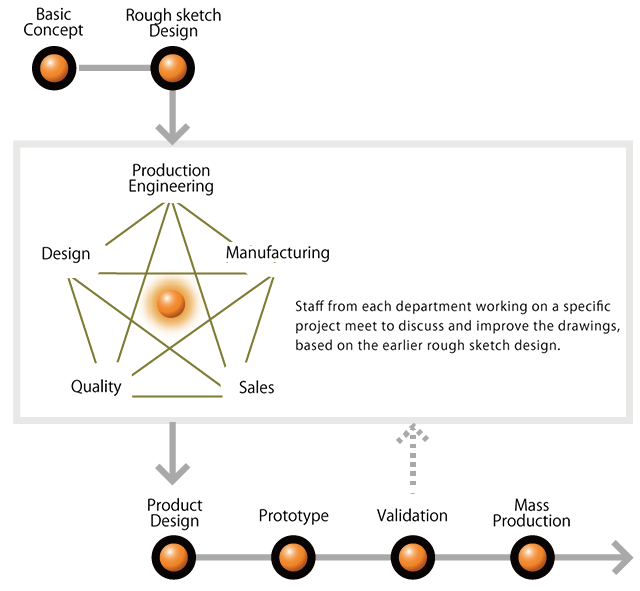Research and DevelopmentDEVELOPMENT SYSTEM
New products and technology are born when we use our technology,
backed by experience, to provide practical solutions to address the customer's needs,
as we forge a special Sango brand of manufacturing capabilities.
With the application of simultaneous engineering, the development
of various elements is carried out simultaneously,
building good quality into mass production products within a short lead time.
Sango's Development Process
Simultaneous Engineering


Competitive Edge in Research and Development

Sango's technology is used to design muffler structure and optimal placement of noise silencing and exhaust gas conversion elements within the system. They are necessary to achieve good engine performance and noise silencing simultaneously, characteristics which normally work against each other.

Sango develops its own materials. In particular, stainless steel used for exhaust systems to withstand high temperature environment. We work together with raw material manufacturers to develop highly functional, low cost material.

To develop an exhaust system that provides maximum performance, Sango optimizes the placement of each components, integrating them into a total system which will meet all targets for function, durability, weight, and cost.

The Design Division works in collaboration with other departments, in order to realize an efficient and optimal design process and to meet expectation of our customers in both performance and quality.

All the equipment and facilities necessary to validate a product's performance and reliability are available in Sango, so that in-house testing can be done and provide immediate feedback to the designers.

To ensure the product's function and reliability, the Quality Assurance Department takes part in development activities from the product planning stage, making sure that good quality is built into the product. Thorough a series of quality audits at each development process, we ensure a firmly implemented development process.
Technical Centers
In pursuit of an efficient development process, we have established technical centers in Japan and in China. Working together between such departments as Advances Development, Design, Testing and Evaluation, Production Engineering, and Quality Assurance at these sites, Sango promotes a speedy process from product development till mass production preparations.

Toyota Technical Center

Yawatayama Technical Center

Guangzhou Sango R&D Center (China)
Testing and Analysis Technology
All testing required to validate the performance and reliability of our product is carried out in-house and the results are immediately fed back to the development process. This is done in concert with high level analysis based on CAE (Computer Aided Engineering) predictive evaluation and optimization.
Testing and Analysis Technology in Exhaust System

■Exhaust noise testing
After making simulation models for the engine, exhaust manifold and exhaust system, exhaust noise is predicted by entering the engine noise source into a model. By carrying out the analysis the designers themselves, development lead time is shortened.

■Exhaust noise testing (anechoic chamber)
Highly precise evaluation of tail pipe noise and radiated noise from the muffler is carried out in an anechoic chamber. In order to block out external vibration and noise, the building is constructed in two sections, with the inner section's surface completely covered with wedge-shaped sound absorption material.

■Exhaust noise testing
(Vehicle testing)
Testing and evaluation is carried out under controlled conditions of an indoor lab with chassis dynamometer. Also we conduct total evaluation of a vehicle and emission testing in special air-conditioned room which can create an extreme low temperature environment.

■Vibration analysis
We conduct analysis to predict exhaust system durability strength with respect to engine vibration, as well as vibration input from the vehicle body, which causes booming noise in the exhaust sound.

■Vibration testing
(engine bench test)
The engine and exhaust system are set up on the test bench in the same package configuration that it would have on the vehicle and with the input of engine vibration, we evaluate the durability strength of the exhaust system as well as exhaust system vibration, which can become the source of booming noise in the exhaust sound.

■Vibration testing
(multiple axis test rig)
By reproducing the engine and body behavior which occurs when the vehicle is driven, we can apply these inputs to the exhaust system and evaluate durability strength.

■Thermal stress analysis
We calculate strain caused by thermal expansion, which occurs when the exhaust manifold is heated by the exhaust gas. The thermal fatigue durability (life span) is predicted based on a cycle of heating and cooling the exhaust manifold.

■Thermal cycle test
(engine bench)
After reproducing the same configuration as the engine and exhaust manifold would have when installed on the vehicle, testing is carried out to evaluate the thermal fatigue durability strength of the exhaust manifold.

■Thermal stress test
(gas burner test bench)
Without requiring an engine, this test rig can use a gas burner to evaluate the thermal fatigue durability strength of the exhaust manifold.

■Gas flow analysis
The gas flow and how it will strike the catalyst and sensors are analyzed, as well as pressure loss are all predicted in this analysis.

■Visualization of flow (PIV*)
We are working to improve the accuracy of our analysis results by combining the results of a test where actual gas flow is made visible in a simplified model with results from flow analysis (CFD).
*Particle Image Velocimetry

■Emission Evaluation
We evaluate the performance of catalytic converter, DPF and urea SCR system to confirm the best form and the effectiveness of our emission control products. Products for both gasoline and diesel vehicles are evaluated in a controlled room where extreme weather of cold winter and hot summer can be created.
Testing and Analysis Technology in Vehicle Body and Chassis

■CAE Analysis
Using CATIA software, CAE Analysis is aggressively applied in order to respond to a variety of customer demands, such as requests for short development lead time, low cost, or high performance.

■Bench Testing
Fatigue testing of individual cross members can be carried out on Sango test equipment. When the development of parts is subcontracted to Sango, the developed parts are tested and evaluated in-house at Sango.
